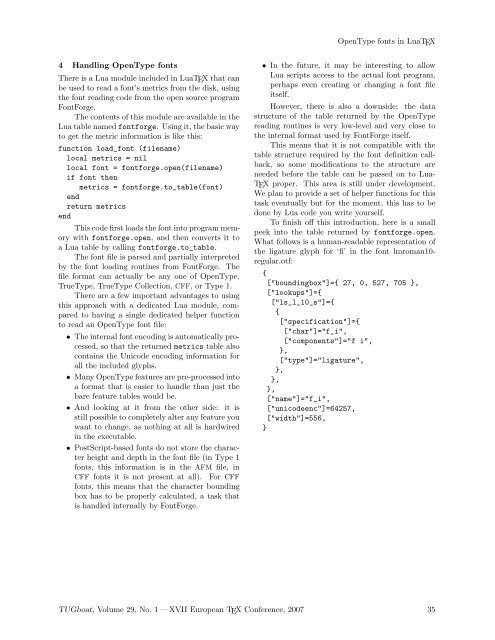Complete issue 29:1 as one pdf - TUG
Complete issue 29:1 as one pdf - TUG
Complete issue 29:1 as one pdf - TUG
Create successful ePaper yourself
Turn your PDF publications into a flip-book with our unique Google optimized e-Paper software.
OpenType fonts in LuaTEX<br />
4 Handling OpenType fonts<br />
There is a Lua module included in LuaTEX that can<br />
be used to read a font’s metrics from the disk, using<br />
the font reading code from the open source program<br />
FontForge.<br />
The contents of this module are available in the<br />
Lua table namedfontforge. Using it, the b<strong>as</strong>ic way<br />
to get the metric information is like this:<br />
function load_font (filename)<br />
local metrics = nil<br />
local font = fontforge.open(filename)<br />
if font then<br />
metrics = fontforge.to_table(font)<br />
end<br />
return metrics<br />
end<br />
This code first loads the font into program memory<br />
with fontforge.open, and then converts it to<br />
a Lua table by calling fontforge.to_table.<br />
The font file is parsed and partially interpreted<br />
by the font loading routines from FontForge. The<br />
file format can actually be any <strong>one</strong> of OpenType,<br />
TrueType, TrueType Collection, CFF, or Type 1.<br />
There are a few important advantages to using<br />
this approach with a dedicated Lua module, compared<br />
to having a single dedicated helper function<br />
to read an OpenType font file:<br />
• The internal font encoding is automatically processed,<br />
so that the returned metrics table also<br />
contains the Unicode encoding information for<br />
all the included glyphs.<br />
• Many OpenType features are pre-processed into<br />
a format that is e<strong>as</strong>ier to handle than just the<br />
bare feature tables would be.<br />
• And looking at it from the other side: it is<br />
still possible to completely alter any feature you<br />
want to change, <strong>as</strong> nothing at all is hardwired<br />
in the executable.<br />
• PostScript-b<strong>as</strong>ed fonts do not store the character<br />
height and depth in the font file (in Type 1<br />
fonts, this information is in the AFM file, in<br />
CFF fonts it is not present at all). For CFF<br />
fonts, this means that the character bounding<br />
box h<strong>as</strong> to be properly calculated, a t<strong>as</strong>k that<br />
is handled internally by FontForge.<br />
• In the future, it may be interesting to allow<br />
Lua scripts access to the actual font program,<br />
perhaps even creating or changing a font file<br />
itself.<br />
However, there is also a downside: the data<br />
structure of the table returned by the OpenType<br />
reading routines is very low-level and very close to<br />
the internal format used by FontForge itself.<br />
This means that it is not compatible with the<br />
table structure required by the font definition callback,<br />
so some modifications to the structure are<br />
needed before the table can be p<strong>as</strong>sed on to Lua-<br />
TEX proper. This area is still under development.<br />
We plan to provide a set of helper functions for this<br />
t<strong>as</strong>k eventually but for the moment, this h<strong>as</strong> to be<br />
d<strong>one</strong> by Lua code you write yourself.<br />
To finish off this introduction, here is a small<br />
peek into the table returned by fontforge.open.<br />
What follows is a human-readable representation of<br />
the ligature glyph for ‘fi’ in the font lmroman10-<br />
regular.otf:<br />
{<br />
["boundingbox"]={ 27, 0, 527, 705 },<br />
["lookups"]={<br />
["ls_l_10_s"]={<br />
{<br />
["specification"]={<br />
["char"]="f_i",<br />
["comp<strong>one</strong>nts"]="f i",<br />
},<br />
["type"]="ligature",<br />
},<br />
},<br />
},<br />
["name"]="f_i",<br />
["unicodeenc"]=64257,<br />
["width"]=556,<br />
}<br />
<strong>TUG</strong>boat, Volume <strong>29</strong>, No. 1 —XVII European TEX Conference, 2007 35

















